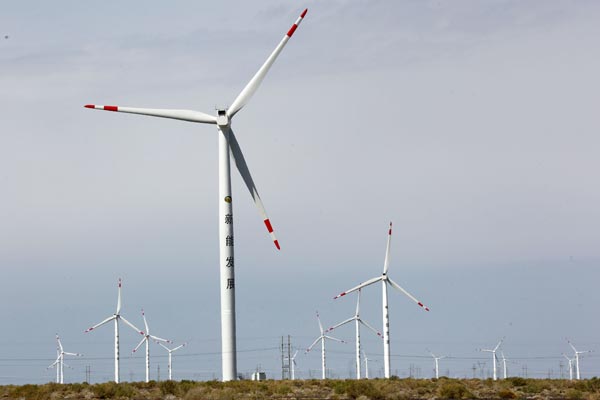China to top green list by 2030
 0 Comment(s)
0 Comment(s) Print
Print E-mail China Daily, November 25, 2014
E-mail China Daily, November 25, 2014
China will become the world's largest renewable energy market by 2030 if it can double the ratio of such sources as solar and wind in the total energy mix to 26 percent, the International Renewable Energy Agency said on Monday.
 |
|
A wind farm in Hami, Xinjiang Uygur autonomous region. China is set to cap carbon dioxide emissions by 2030 and increase the share of nonfossil energy in total primary energy supply to about 20 percent by then.?[Photo/China Daily] |
The agency, in cooperation with the China National Renewable Energy Center, released a report in Beijing titled Renewable Energy Prospects: China, in which it said that using more such energy in China will improve millions of lives and save billions of dollars, taking into account the costs of healthcare and the savings achieved by reducing emissions.
In particular, it said, China can double its use of renewables in the power sector to 40 percent by 2030.
"As the largest energy consumer in the world, China must play a pivotal role in the global transition to a sustainable energy future," said Adnan Z. Amin, director-general of the agency.
China's energy consumption is expected to increase 60 percent by 2030, which means that how China meets its needs will determine whether the world can curb climate change, said Amin. He said a recent announcement by China and the United States to cope with climate change will boost investments in renewables. China and the US made that announcement on Nov 12.
China aims to cap carbon dioxide emissions by 2030 and expand the share of non-fossil energy in the total primary energy supply to about 20 percent by 2030.
Amin said China will play a leading role in flighting climate change by acting now to implement more renewable energy projects.
According to the report, the share of renewables in China's total energy mix will only rise to 17 percent by 2030 under current policies. But if China can accelerate the pace, it will reach 26 percent.
The energy agency estimated that annual investment of $145 billion is needed between now and 2030 in renewable energy technologies to reach the 26 percent goal.
Dolf Gielen, director of the Innovation and Technology Center at the IRENA, said that two-thirds of the investment will go into the power sector including wind, solar and hydropower.
He said to achieve the carbon reduction target, nuclear and hydropower in China must play big roles. "China can achieve the energy revolution it is aiming for — and it can do so affordably," said Gielen.
The higher renewable share will result in annual savings of $55 billion to $228 billion by 2030 when taking into account factors such as human health and reduced emissions.
Renewable energy is China's choice to ensure energy supply and solve pollution problems, said Shi Lishan, director of the new energy and renewable energy department at the National Energy Administration.
However, many solar, wind and hydropower plants cannot be connected to the grid, which is still a "severe obstacle" to the development of the renewable energy industry, he said. Further, solar technology still needs improvement.
According to the IRENA, China increased its renewable energy capacity in 2013 by more than Europe and the rest of the Asia-Pacific region combined.





